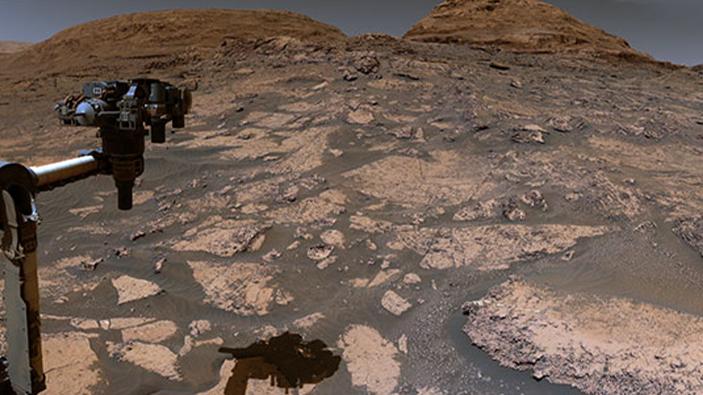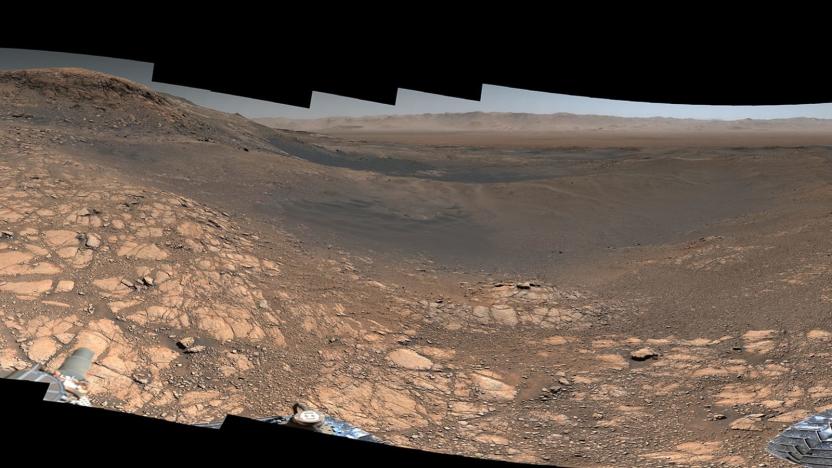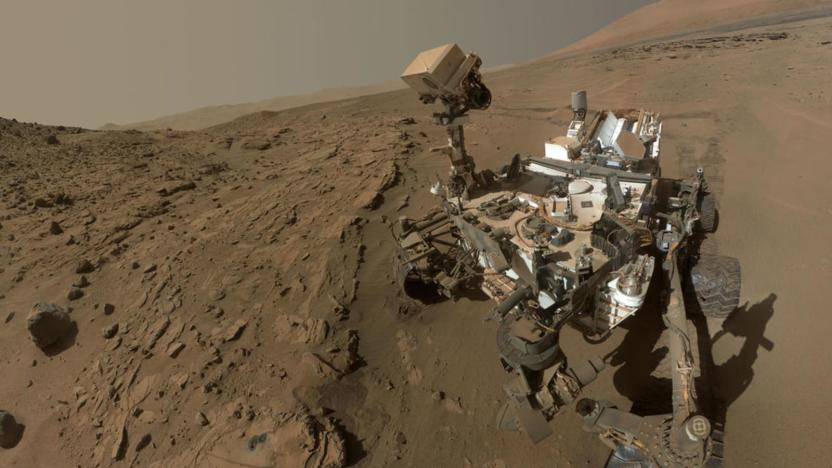Curiosity Rover
Latest

NASA's Curiosity rover video shows a fresh panoramic view of Mars
A progress report from the Curiosity Rover.

Explore Mars with a 1.8-billion-pixel panorama from the Curiosity rover
NASA's Curiosity rover has sent the highest-resolution panorama of Mars ever taken back to Earth. Now, you can explore the Martian surface by zooming in on the giant 2GB image or cruising around in a 360-degree video that NASA shared on YouTube.

Curiosity rover finds gas levels on Mars hinting at possibility of life
It's easy to get jaded about potential signs of life on Mars, but a recent discovery might raise eyebrows. The New York Times has learned that NASA's Curiosity rover has detected "startlingly high" levels of methane -- the gas typically produced by life as we know it. The quantities are still tiny at 21 parts per billion, but that's three times the amount Curiosity spotted during a surge in 2013. The rover's operators were reportedly surprised enough to pause regularly scheduled studies to obtain follow-up data, with the additional findings slated to arrive on June 24th.

The photos you (probably) won't find on Instagram
Photography reached the mainstream early on; Kodak's Brownie made daily snapshots accessible and Polaroid's pioneering cameras provided instant gratification. Now we can capture and share moments on a whim with smartphones packing high-resolution optics. Over the years, though, we've been treated to some incredible imaging hacks that've allowed our eyes to travel into the exotic -- far beyond what you had for dinner last night. Technological leaps in the field have been spurred by bets, accidents and imagination, providing both scientific insight and artistic experimentation. Our eyes have been opened wider than ever before and we've collected just a few moments in imaging's history to help grasp the bigger picture. [Image: Google Research]

Life on Mars cast into doubt as Curiosity fails to find methane
[Click] Hi, is that David Bowie? [Silence] ... It's NASA here. We've got some news. While it's not a conclusive answer, the Curiosity Rover wasn't able to detect any traces of methane in the Gale Crater. Presence of the gas is one of the things that we were hoping would support our theories about life on Mars, so this comes as a bit of a blow. Now, there *are* terrestrial microbes that don't generate methane, so it's not as if this is a firm "no," but it's not looking anywhere near as likely as it was before. So, uh, does that help at all? [Silence] ... Uh, well, thanks. Bye! [Click]

Watch the Curiosity rover explore Mars in one minute (video)
It hasn't even been a year from the time NASA's Curiosity rover landed on Mars, yet it already boasts a number of accomplishments. All the while, Opportunity's successor has been sending images back to Earth documenting its numerous great deeds, and a fan of the rover's work has compiled many of the them into the video you can find after the break. So, now you can get a glimpse of Curiosity capturing awe-inspiring shots of Mount Sharp, unearthing evidence of liquid water, determining the alien soil's chemical composition, and discovering conditions that could've allowed microbes to thrive on the red planet, all in the span of a minute. Hit play to check out what Curiosity's been up to from its first through its 281st Sol -- or Martian day -- as well as to see the extraterrestrial lands our grandchildren might occupy in the future.

Curiosity rover drills into Martian rock, looks for more evidence of water
NASA scientists won't have to wait until InSight's 2016 drilling mission to see what lies beneath the surface of Mars -- Curiosity is already on the case. After developing a taste for Martian soil late last year, the intrepid rover has started exploring the red planet's bedrock, drilling a 0.63 inch (1.6 cm) wide hole 2.5 inches (6.4 cm) deep into Mars' surface. Curiosity will spend the next several days analyzing the resulting powder in hopes of finding evidence of a once-wet planet. The shallow hole marks the first drilling operation ever carried out on Mars, and getting there wasn't easy. "Building a tool to interact forcefully with unpredictable rocks on Mars required an ambitious development and testing program," explained Louise Jandura, the chief engineer of the rover's sample system. "To get to the point of making this hole in a rock on Mars we made eight drills and bored more than 1,200 holes in 20 types of rock on Earth." The Rover tested its drill by creating a shallower hole earlier this month, though samples will only be used from the second, deeper cavity. Check out the source link for more images of the operation, including an animated GIF of the drill in action.

Visualized: Curiosity rover's self-portrait
No, Disney isn't working on Wall-E the live action movie. Pictured above is a self-portrait of NASA's Curiosity rover resting in the Gale crater of Mars. Showcasing some extreme detail, this high-res photo was captured by the Red Planet roller's Mars Hand Lens Imager (MAHLI), with its native image clocking in at 5,463 x 7,595 pixels. The picture's Martian backdrop consists of a trail of freshly made tire tracks with a glimpse of Curiosity's future destination Mount Sharp hanging out in the distance. If you gaze deeply into the unmanned craft's soulless robotic eye, you'll catch a reflection of Mars staring right back at you. To get a closer look at our favorite Martian in all of its uncompressed glory, you can snag the 125MB image file from the second source link below. [Image credit: NASA/JPL-Caltech/Malin Space Science Systems]

NASA's Curiosity rover checks in on Foursquare, gives Mars its first mayor
Yes, seriously. NASA announced on Wednesday that its Curiosity rover had "checked in" on Mars via Foursquare. Marking the first check in from another world, the robotic rover will utilize the location-minded social network to share updates and pictures while visiting the Red Planet. While Curiosity will continue to explore the possibilities of Mars being able to sustain life, it would appear that the fourth planet from the sun just got a brand new mayor. Something tells us the universe's rarest badge is about to be bestowed.

NASA's Curiosity rover finds ancient streambed on Mars, evidence of 'vigorous' water flow
Curiosity may have spent a while limbering up for the mission ahead, but now it's found evidence of an ancient streambed on Mars that once had "vigorous" water flow. Photos of two rock outcroppings taken by the rover's mast camera between the north rim of Gale Crater and the foot of Mount Sharp reveal gravel embedded into a layer of conglomerate rock. The shape of the small stones indicate to NASA JPL scientists that they were previously moved, and their size (think from grains of sand to golf balls) are a telltale sign that water did the work instead of wind. Evidence of H2O on Mars has been spotted before, but this is the first direct look at the composition of riverbeds NASA has observed from above. According to Curiosity science co-investigator William Dietrich, it's estimated that water flowed at the site anywhere from thousands to millions of years ago, moved at a clip of roughly 3 feet per second and was somewhere between ankle and hip deep. "A long-flowing stream can be a habitable environment," Mars Science Laboratory Project Scientist John Grotzinger said. "It is not our top choice as an environment for preservation of organics, though. We're still going to Mount Sharp, but this is insurance that we have already found our first potentially habitable environment."

Curiosity rover starts light robotic arm workout in preparation for scientific main event
As NASA promised, Curiosity has stopped at the quarter pole toward its first scientific destination to test its robotic arm and attached scientific instruments. After 100 yards of driving, the rover extended its 7-foot limb, and will now spend six to ten days checking its predetermined positions and range of motion. That will ensure the appendage is ready after surviving the chilly vaccuum of space and subsequent setdown, and will let its minders see how it functions in the unfamiliar Martian gravity and temperatures. The JPL scientists in charge of the six-wheeler will also peep the Mars Hand Lens Imager and made-in-Canada Alpha Particle X-Ray Spectrometer to warrant that they're up for all the geology to come. If all goes well, the rover will start scooping, drilling and analyzing in earnest when it hits Glenelg, then Mount Sharp -- so, we'd limber up first before tackling all that, too.

Mars Curiosity leaves its landing area, heads to distant frontier a quarter-mile away
Now that Curiosity has survived its thrill-a-minute landing and passed an upgrade and physical with (nearly) flying colors, the rover is off to earn its $2 billion keep. The trip started well, with the buggy driving 52 feet towards its first science site "beautifully, just as our rover planners designed it," according to NASA. The destination, Glenelg, is 1,500 feet away from the now-familiar Bradbury Landing where it first set down, which is pretty far for a rover that treks along at about a tenth of a mile per hour. On top of that, its minders have some stops in mind to test instruments -- meaning it'll arrive there in about two weeks. Once at Glenelg, Curiosity will scope the unusual geology of the region, though its principal destination for science is Mount Sharp, a relatively vast six miles away. Don't worry about it running out of gas, though -- the nuclear power supply will last a full Martian year, or 687 earth days.

Voice signals sent to Mars and back, while telephoto images tease rich geology
The Martian hills are alive with the sound of music. Well, NASA Administrator Charles Bolden's voice at least, as the agency reveals that the first recorded human voice has traveled from Earth, to another planet, and back. The words might not have literally echoed in the surrounding hills, but by having been beamed to Curiosity and back again, have made a small step towards interplanetary communication. Along with the motivational words of Bolden, the rover returned some telephoto images from the onboard 100mm and 34mm lenses. The pictures show the hills toward which Curiosity is bound, and tease the scientists with their rich-looking -- and hopefully revealing -- layers of geology. Want to know what interplanetary voicemail sounds like? No need to go to Mars and back, just click on the more coverage link below.

Rovio takes Angry Birds Space for a spin with NASA's Curiosity Mars Rover, teases Red Planet for fall (video)
It was almost as inevitable as gravity, really. Rovio has teamed up with NASA to offer a special, Curiosity-themed episode inside Angry Birds Space. The trek has the avians scouring 20 levels of the Martian landscape with a few bonuses thrown in for good measure. Just like your favorite childhood breakfast cereal, there's even a token healthy ingredient -- in this case, a chance for gamers to learn about Curiosity's exploration whenever they're not busy smashing pigs. Android and iOS users can dip into the new chapter right after they update, but that's not even the full extent of Rovio's plans. If the environs of Gale Crater are too limiting, you'll be glad to hear that the game developer is teasing a full-scale Red Planet variant for the fall.

NASA InSight tapped for Mars drilling mission in 2016
The surface of Mars? Psh... been there. With the Curiosity stage well under way, our exploration of the Red Planet is about to take a dive beneath the dust. Interior Exploration using Seismic Investigations, Geodesy and Heat Transport -- InSight, for short -- was just confirmed as a new NASA mission, with the space agency set to launch in March of 2016. Based on the Phoenix lander, the craft is tasked with giving us a peek beneath the planet's surface, armed with tools that include a geodetic instrument from the Jet Propulsion Laboratory, which will be used to calculate Mars' rotation axis, a seismic wave sensor and a subsurface heat probe, to measure the planet's internal temperature. The program has a $425 million budget -- a bit shy of the $2.5 billion allocated for Curiosity -- not including the costly launch vehicle. NASA Administrator Charles Bolden said that InSight will help pave the way for future human missions to Mars, and represents just one of the related projects to come. Hit up the source link below for a closer look at JPL's latest endeavor.

Curiosity landing video assembled from high-res images (video)
A new video has been compiled by Spaceflight101.com showing Curiosity's final minutes of terror in glorious HD (though a dearth of frames and lack of stabilization make it a bit herky-jerky). It's an assembly of all the high-res photos taken by the buggy on the way down to its now familiar perch, rolling at the not-exactly-HFR speed of 4 fps, but still trumping a previous low-res thumbnail version. It gives a much clearer, rover's-eye-view of the journey, starting with the heat shield ejection and finishing with the dusty, butterfly-like touchdown. Check it out below the break to see the precarious descent -- and don't forget your Dramamine. Update: An enterprising (and patient) individual, Dominic Muller, spent four straight days creating a frame interpolated version of the video, giving the choppy footage a beautiful, smooth new look. Check out his version below the original after the break -- blow it up to full screen HD, crank the sound and enjoy.

Curiosity rover warms up its laser with basaltic rock blast
Intrepid 6-wheeler Curiosity perhaps protested too much when it tweeted "Yes, I've got a laser beam attached to my head. I'm not ill tempered; I zapped a rock for science." NASA turned the rover's high-powered laser loose with 30 pulses of a million watts each, reducing a thin layer of the chosen stone, dubbed N165 "Coronation," to plasma. The resulting spectrum was then analyzed by the on-board "ChemCam" to determine its composition, and the US/French team who developed the system said it's working even better on Mars than it did on terra firma. The results are now being studied, but if we had a laser beam on another planet, we'd be firing it all over the place -- in the name of "science," of course.

NASA maps out proposed travel plans for Curiosity, decides to head for the hills
As the vista on Mars gradually gets ever clearer, and the system checks continue to show that the rover is in good stead, the team behind Curiosity will be increasingly eager to stretch its legs wheels. The first trip might be just a cautious few meters, but plans for a more adventurous jaunt have just been revealed. The first location in Curiosity's sights is an area referred to as Glenelg, which, based on initial pictures, offers three different geological characteristics, as well as potentially being an area where water used to be present. The site is only 1,300 feet (400 meters) from where the rover landed, but it could still take several weeks to get there. This is merely a quick dash compared to the next leg of its journey, which sees Curiosity heading out to an area called Mount Sharp -- a large mound of layered rock which is hoped to contain visible geology potentially dating back millions of years. With seven kilometers (4.4 miles) lying between the rover and the mountain's foothills, it'll be a much longer journey, but one that could provide the first real evidence of the planet's ability to host, or have hosted, life.

Visualized: Mars' Gale Crater in seamless 360 degrees
Have you been lapping up every pixel Curiosity sends back, but wishing you could somehow see those panoramas as nature intended? Well, thanks to kind 360 Cities user Andrew Bodrov, you can. The controls take a little getting used to, but persevere and you'll be rewarded with a view as if you were atop Curiosity itself. We're already imagining the fun if this was in the next Google Maps update, who knows what might turn up. Land on the source for the mind-blow.

Life on Mars: One week of Curiosity
Is there life on Mars? NASA's latest mission to the red planet might well answer that question, or perhaps the more pertinent question, was there life on Mars. At 10:02 AM EST on November 26th last year, the space agency's Mars Science Laboratory (to give the mission its full name) set off on its eight-month journey to the red planet. The most advanced equipment ever sent to the planet -- and the biggest-ever rover -- should allow exploration of some of the most interesting regions, over far larger distances than ever previously covered. On arrival, after negotiating a tricky landing, the mobile laboratory (that's Curiosity) will spend a Martian year (687 Earth days) analyzing rock samples and seeking evidence of conditions suitable for microbial life or -- we can live in hope -- actual evidence of the same. After the break, we take a look at some of the key events over the first seven days on the planet's surface.










